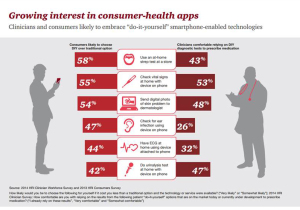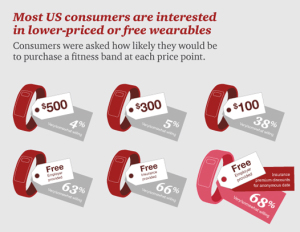
There’s growing interest among both consumers and clinicians in people DIY’ing healthcare. Consumers are even keener than their doctors about the self-care concept, PwC’s Health Research Institute has found.
Doctors who are already in value-based payment mode — participating in accountable care organizations, at-risk for reimbursement, doing population health — are earlier adopters of digital health tools that enable patients to care for themselves outside of the health care setting. These providers are also working more on care teams, where physicians can work at their ‘highest and best use,’ complemented by nurse practitioners, physician assistants, diabetes educators, and other ancillary clinical professionals who can extend the physician’s time and workflow.
PwC polled both providers and consumers to gauge their respective interests in digital health technologies. The chart illustrates that greater preference among consumers for five of the six technologies assessed, with the exception of patients doing urinalysis tests at home with a device on the phone, favorite by more doctors than patients (47% vs. 42%). Consumers prefer, in greater numbers,
- Using an at-home strep test at a (retail) store
- Checking vital signs at home with a device on their phone (with nearly as many doctors comfortable with this, 55% vs, 53%)
- Sending digital photo of skin problem to the dermatologist
- Checking for an ear infection suing a device on their phone
- Having an ECG at home using a device attached to a phone.
The two most significant concerns for providers adopting mobile health technologies are privacy and financial issues – especially the doctor’s perspective that “I don’t get paid to use mobile health tech or delivery digitally,” the survey discovered. The expense of digital tech as a concern has dropped from 35% of physicians in 2010 to 24% with the concern in 2014.
Concerns about workflow are also increasing, with only 18% of doctors concerned about workflow challenges in adopting digital health, up to 24% in 2014.
The most common mobile device activities among physicians are accessing EMRs (among 45%), prescribing meds (aka ePrescribing, for 41%), reviewing images (32%), and communicating with patients (31%).
 Health Populi’s Hot Points: There were several surprises in the PwC survey data which demonstrate a moving needle for physician adoption of digital and mobile health tools. The 31% of physicians who reported communicating with patients on a mobile device in 2014 is noteworthy, as well as 14% of physicians who receive data from a mobile app a patient uses to track data.
Health Populi’s Hot Points: There were several surprises in the PwC survey data which demonstrate a moving needle for physician adoption of digital and mobile health tools. The 31% of physicians who reported communicating with patients on a mobile device in 2014 is noteworthy, as well as 14% of physicians who receive data from a mobile app a patient uses to track data.
Among the 40% of physicians who monitor patient data generated by a mobile health app or digital tool, 83% told PwC that doing this is, at least, somewhat helpful. However, the challenge to scaling this and optimally benefiting from patient-generated data (PGD) is overcoming the lack of connectivity between the PGD and the clinician’s electronic health record. If clinicians are to fully embrace and succeed with value-based payment and population health, incorporating PGD into the EHR to build a more complete picture of a patient’s life (outside of the doctor’s office, at home where she “lives, works, plays, and learns”) is crucial as, for non-communicable diseases and chronic conditions, the healthcare outcome has more to do with daily living and self-care than in episodic visits to the health care system.
For patients, there’s another important finding from a recent PwC survey on wearables to weave into this story. That data point is that consumers would prefer that digital health technologies for DIY health be free, or better yet in the eyes of the consumer, have use of the device paid-for by a third party. So consumers, too, have their financial obstacles related to adopting digital health tech. Free may not be cheap enough.




 I'm in amazing company here with other #digitalhealth innovators, thinkers and doers. Thank you to Cristian Cortez Fernandez and Zallud for this recognition; I'm grateful.
I'm in amazing company here with other #digitalhealth innovators, thinkers and doers. Thank you to Cristian Cortez Fernandez and Zallud for this recognition; I'm grateful. Jane was named as a member of the AHIP 2024 Advisory Board, joining some valued colleagues to prepare for the challenges and opportunities facing health plans, systems, and other industry stakeholders.
Jane was named as a member of the AHIP 2024 Advisory Board, joining some valued colleagues to prepare for the challenges and opportunities facing health plans, systems, and other industry stakeholders.  Join Jane at AHIP's annual meeting in Las Vegas: I'll be speaking, moderating a panel, and providing thought leadership on health consumers and bolstering equity, empowerment, and self-care.
Join Jane at AHIP's annual meeting in Las Vegas: I'll be speaking, moderating a panel, and providing thought leadership on health consumers and bolstering equity, empowerment, and self-care.